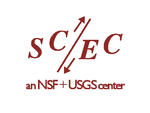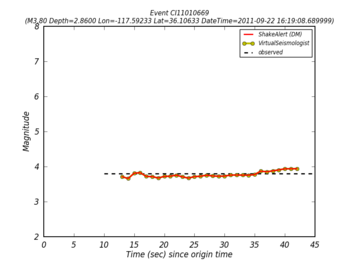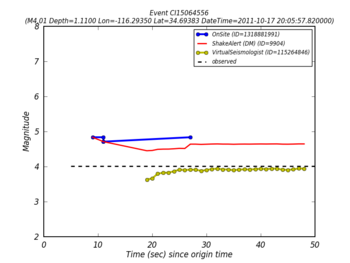Difference between revisions of "CTC Results"
| Line 24: | Line 24: | ||
[[File:Scec.eew.EEWTest.eewTest ShakeAlertMagnitude-Test Magnitude3.5 Event11010669.png.1316761668.413857.1.png|right|350px|Fig 1. Example CTC Performance Summary for ShakeAlert on recent California earthquake showing Algorithm performance (Virtual Seismologists) and Decision Module performance (ShakeAlert).]] | [[File:Scec.eew.EEWTest.eewTest ShakeAlertMagnitude-Test Magnitude3.5 Event11010669.png.1316761668.413857.1.png|right|350px|Fig 1. Example CTC Performance Summary for ShakeAlert on recent California earthquake showing Algorithm performance (Virtual Seismologists) and Decision Module performance (ShakeAlert).]] | ||
| + | |||
| + | |||
| + | [[File:VS_OnSite_and_ShakeAlert.png|right|350px|Fig 2. Example CTC Performance Summary for ShakeAlert on recent California earthquake showing Algorithm performance (Virtual Seismologists and OnSite) and Decision Module performance (ShakeAlert).]] | ||
== CTC Interactive Performance Summaries == | == CTC Interactive Performance Summaries == | ||
Revision as of 17:18, 20 October 2011
The CISN Testing Center (CTC) consists of scientific analysis software, CISN EEW algorithm performance reports, and earthquake observational data. This entry is a collection point for current and past results from the CTC testing center.
CTC ShakeAlert Testing
As of September 2011, CISN Testing Center (CTC) processing now evaluates performance of the prototype CISN ShakeAlert EEW system. CTC evaluations are now based on earthquake parameter forecasts as logged by the CISN ShakeAlert system at U.C. Berkeley.
This testing include inputs from three algorithms (UCB Elarms, ETH Virtual Seismologist, and Caltech Onsite) as well as processing outputs from the ShakeAlert Decision Module.
The CTC automated testing center uses the following processing steps in its evaluation:
- Evaluations are run once per day.
- In order to let evaluation EEW alerts against "final" "stable" earthquake parameters, evaluations are delay for two days. That is on Tuesday, evaluations are done for the previous Sunday.
- Evaluation processing retrieves observed earthquake information from the ANSS catalog.
- ANSS catalog entries are filtered and earthquake below Mag 2.5 or outside the state of California are discarded.
- Evaluation processing retrieves ShakeAlert log files from operational server at UCB.
- For each ANSS earthquake, we look for one or more ShakeAlert triggers with origin time within 45 seconds of the observed earthquake.
- Plots are produced showing final (observed, ANSS) magnitude as compared to algorithm alerts from VS, OnSite, and ElarmS and Decision Module alerts (as sent to users).
The automated nightly evaluation results are posted at the following location.
CTC Interactive Performance Summaries
Prior to September 2011, CTC testing center produced interactive test results for individual EEW algorithms. These results lack information about the integrated ShakeAlert system. The most recent CTC development, described above, now include evaluation information about both individual algorithms as well as overall ShakeAlert performance. The interactive CTC performance summaries produced in the past are posted below, but this software is no longer under active development.
Interactive performance summaries are produced with a specific version of the CTC software in order to manage changes and improvements to the CTC processing software. These performance summaries are cumulative, with later summaries containing more events. Interactive results are reproducible by scientists as both the input EEW performance reports, and processing source code, are available from the CTC testing center.



